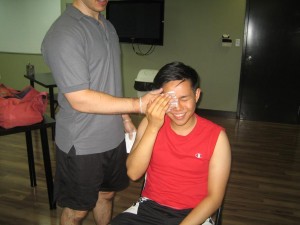When it comes to eye injuries, the cornea is commonly affected which is the clear, protective window located at the front part of your eye. Various debris and particles such as dirt, dust, sand, metal, wood shavings and even an edge of a piece of paper can cut or scratch the cornea. In most cases, the scratch is superficial and this is commonly known as a corneal abrasion. In some cases, it can become infected where a corneal ulcer develops, thus it is considered as a serious problem.

Causes of Corneal Abrasion
Corneal abrasions can be painful where individuals complain of having sand in their eye and some usually develop a headache. There are various scenarios that can cause corneal abrasion.
- Exposure to sand, dirt, ash, sawdust and other foreign materials
- Being poked in the eye by a plant, makeup brush or fingernail
- Excessive rubbing of the eye
- Chemical burns
- Dirty or ill-fitting contact lenses
- Certain eye infections
- Inadequate protection of eyes during surgery while under general anesthesia
Always remember that the symptoms of a corneal abrasion will not manifest right away. With this in mind, it is difficult to determine what actually caused it.
Symptoms of corneal abrasion
Once an individual has corneal abrasion, the unrelenting pain and discomfort can be unforgettable for some. The symptoms include:
- Sensitivity to light
- Sandy feeling in the eye
- Eye pain especially when closing or opening the eye
- Tearing and redness
- Blurred vision or loss of vision
It is important to seek immediate medical attention once these symptoms are present.
Steps to take before medical care is provided
- Rinse the eye using clean water or saline solution if available. Utilize a small drinking glass or cup that is that is situated with its border over the bone at the root of the eye socket. It might help rinse out the foreign object present in the eye.
- Instruct individual to blink the eye numerous times. This might remove the foreign objects present in the eye.
- Tug the upper eyelid above the inferior eyelid so that the lashes of the lower eyelid will brush out any foreign particle that might be present in the lower surface of the upper eyelid. Just be careful to avoid unnecessary actions that might worsen the condition.
- Avoid removing a foreign object that is embedded in the eyeball. Do not remove large objects that will make it difficult for the eye to close.
- Instruct individual to avoid rubbing the eye after an injury since it will worsen the corneal abrasion.
- Instruct individual to avoid touching the eyeball with tweezers, cotton swabs and other instruments since it will make the problem worse.
Always remember that minor corneal abrasions typically heal on their own within 24-48 hours. In case it is a severe one, always seek immediate emergency assistance or go directly to a hospital.